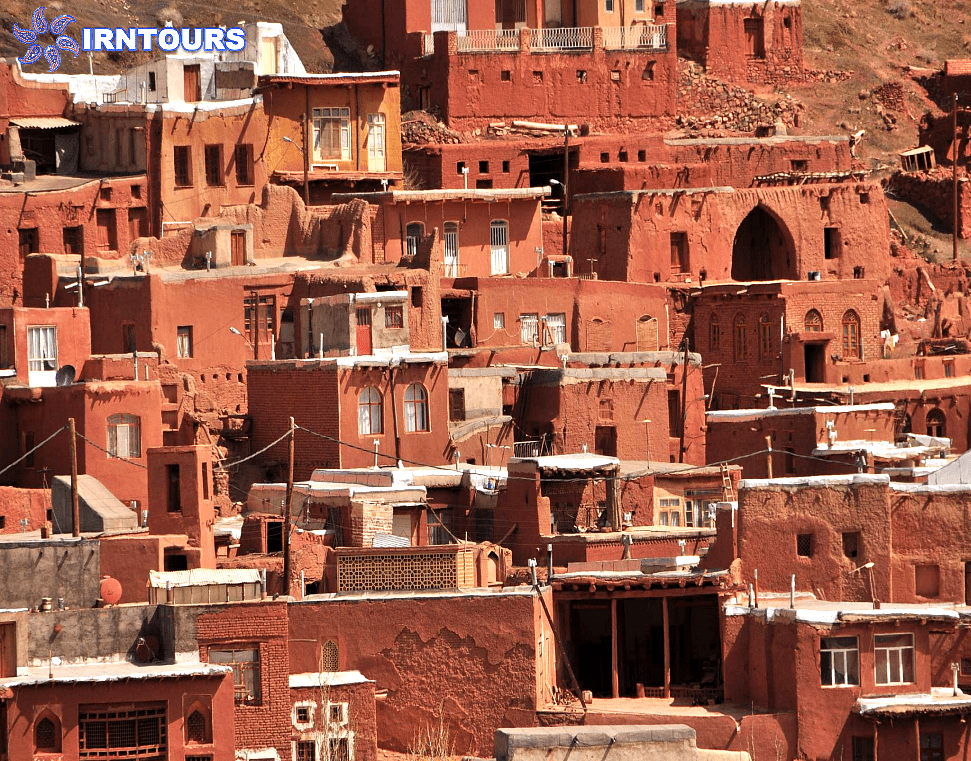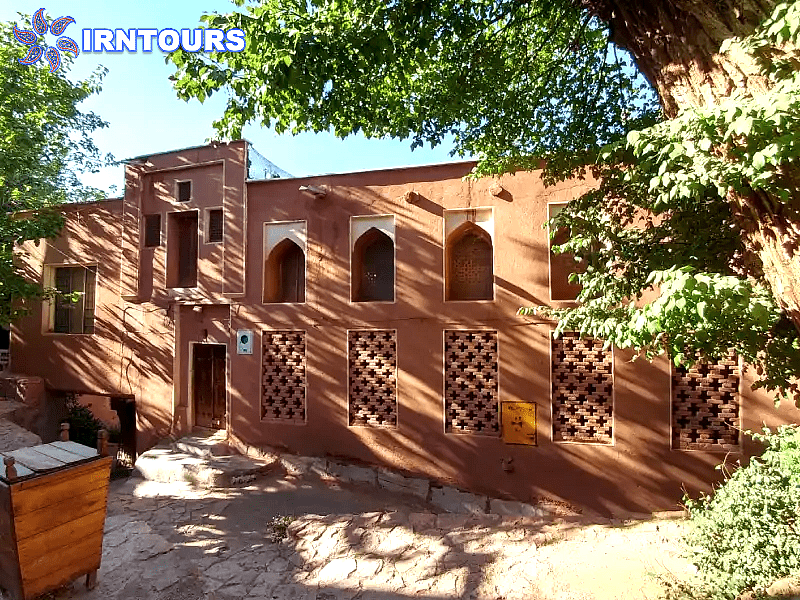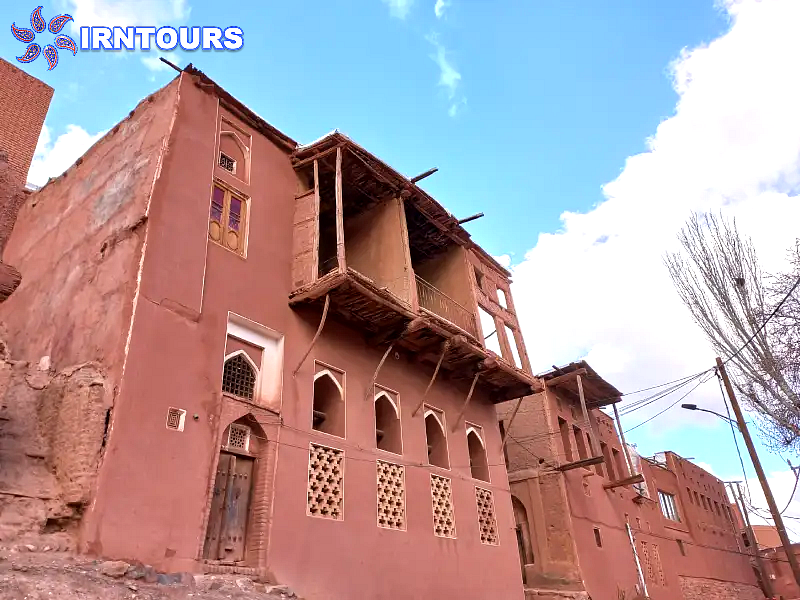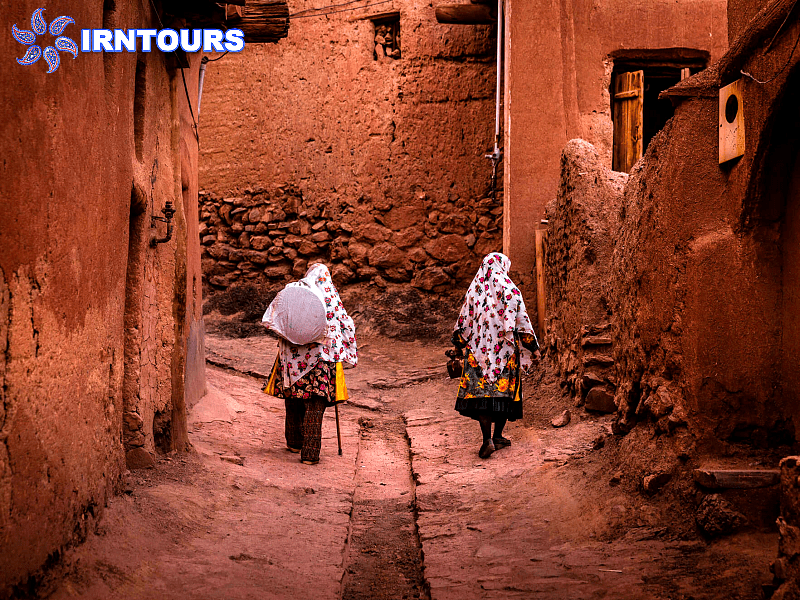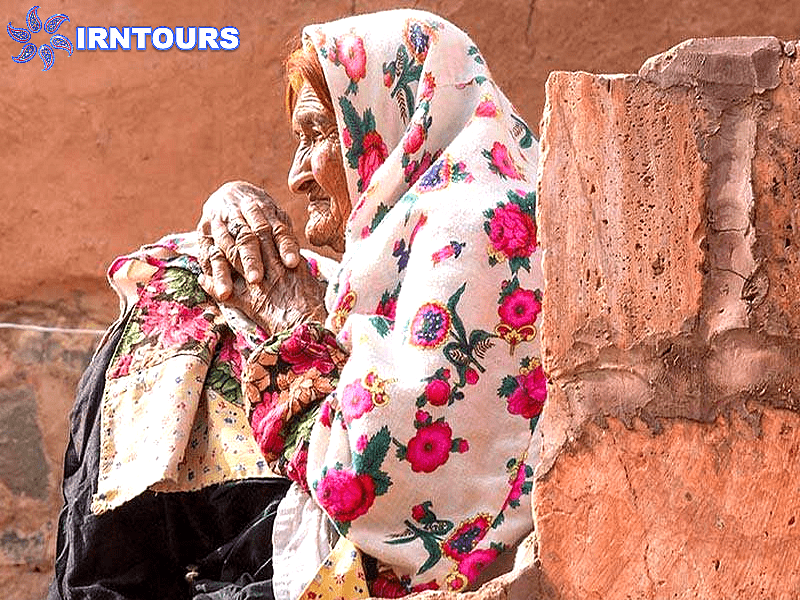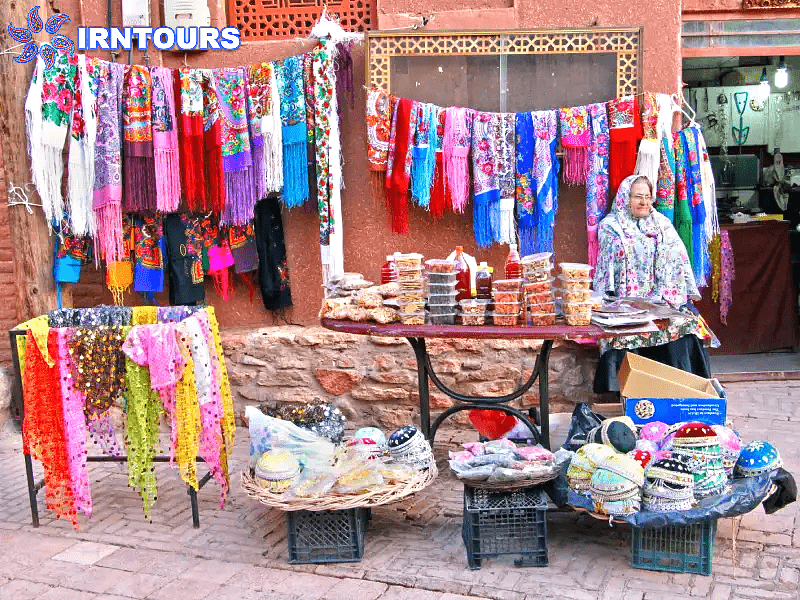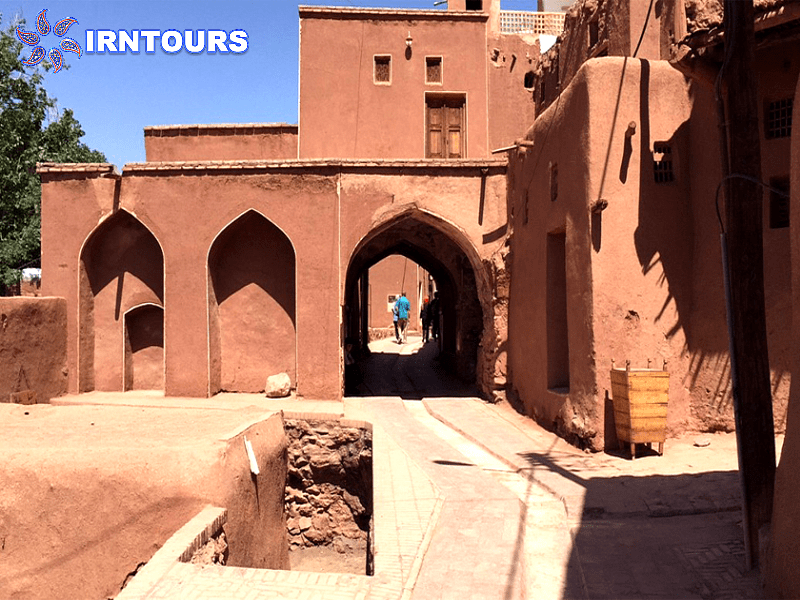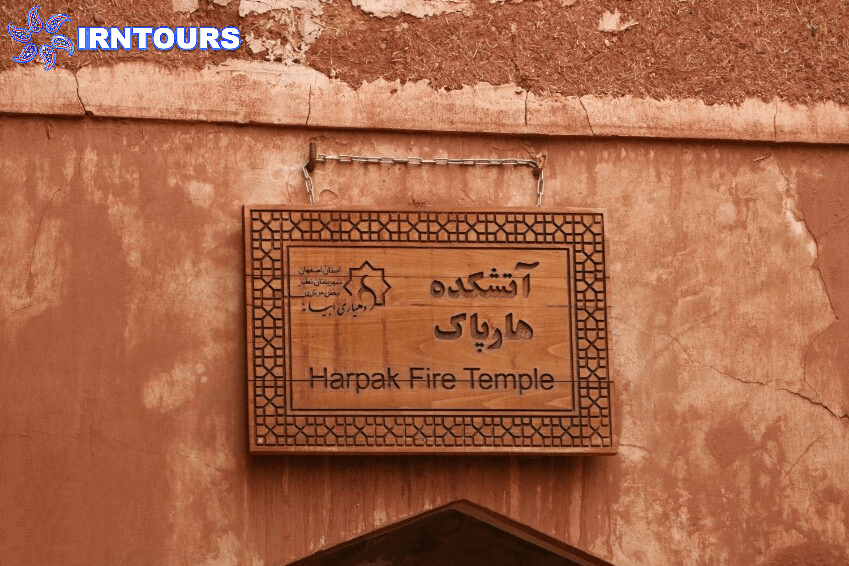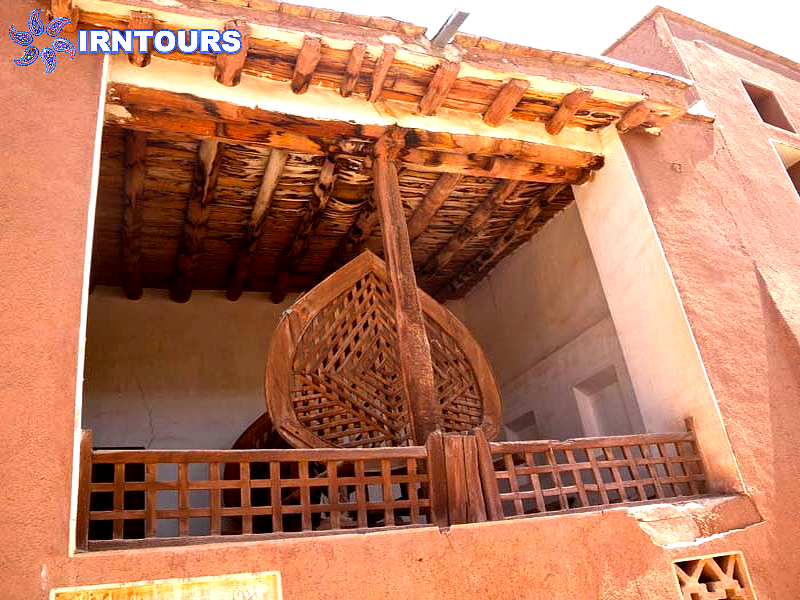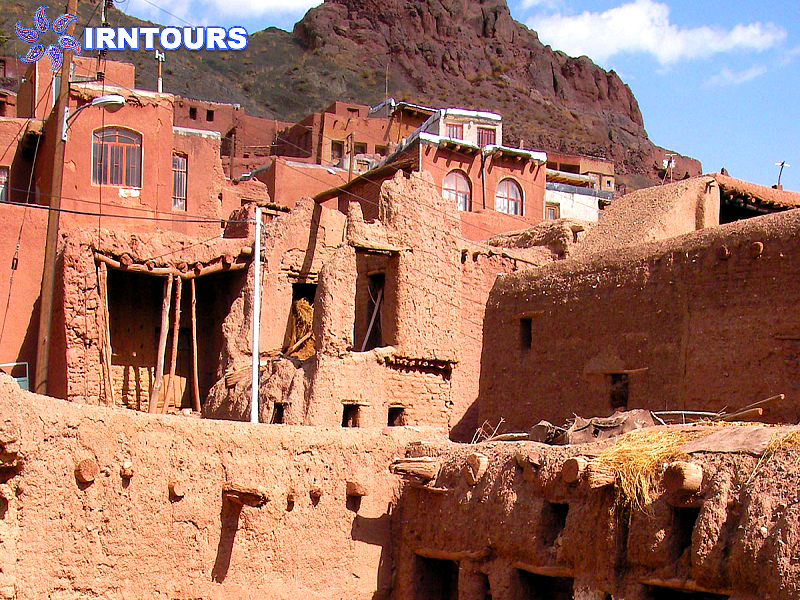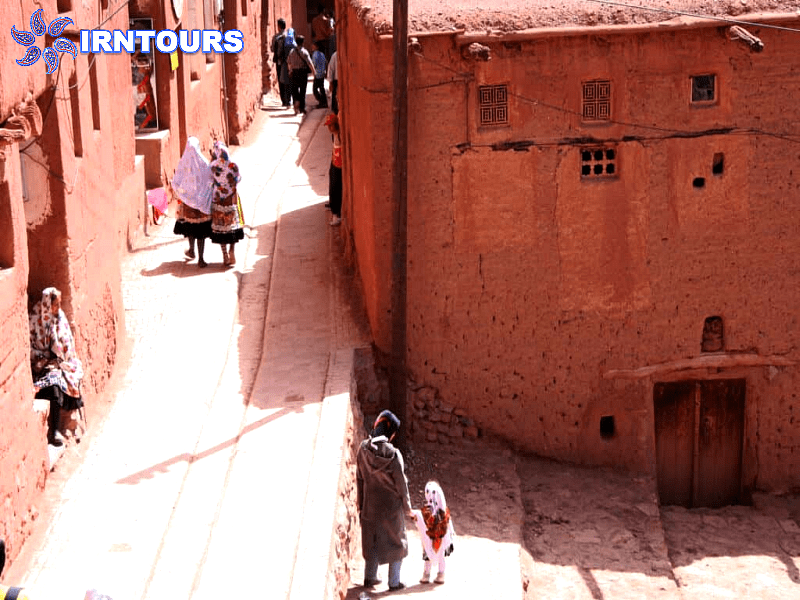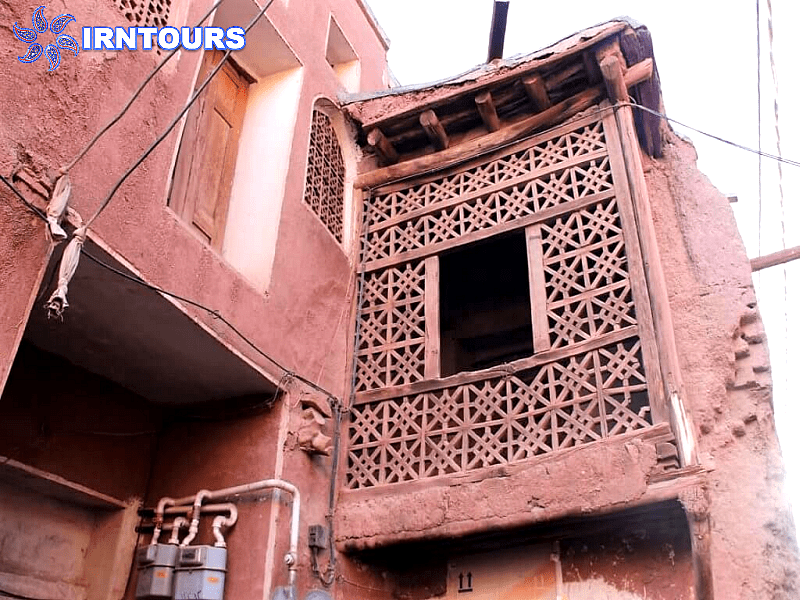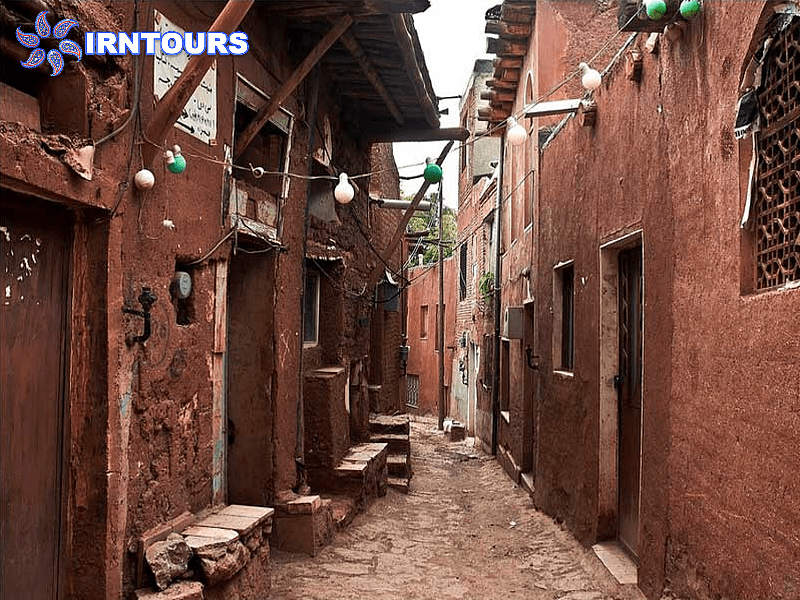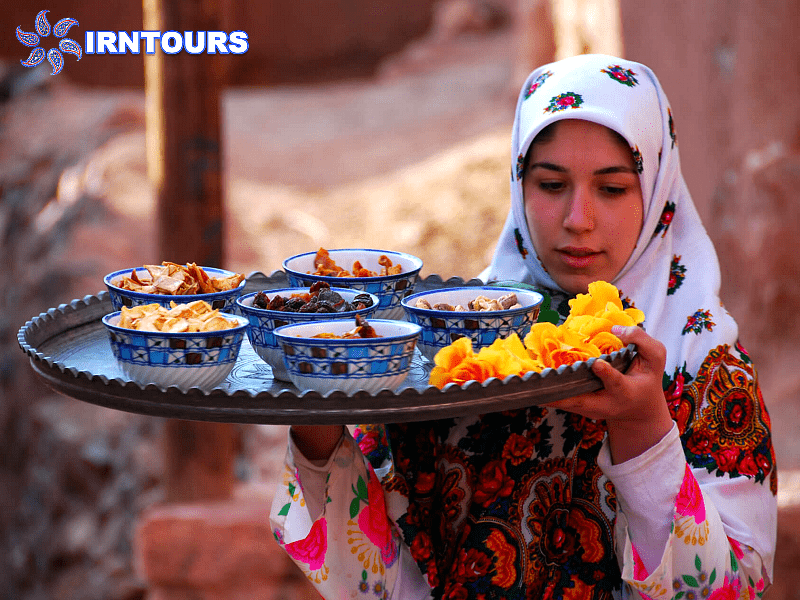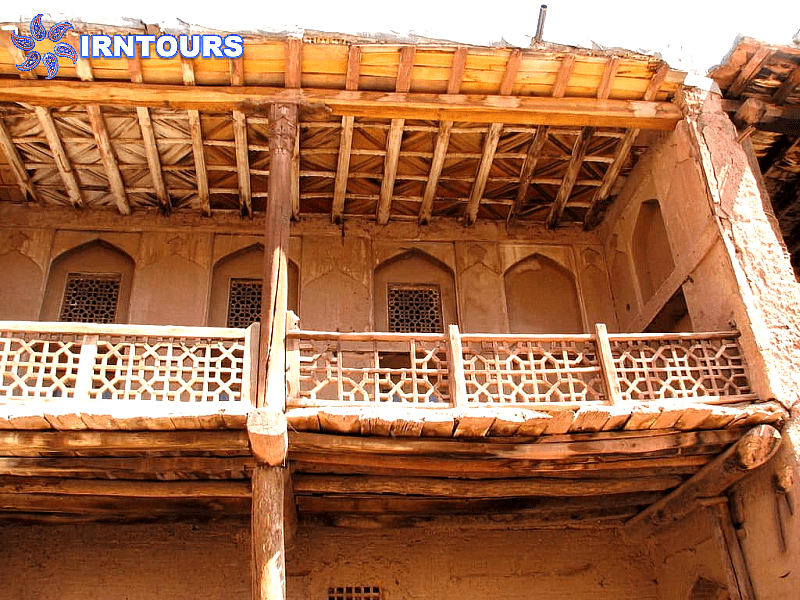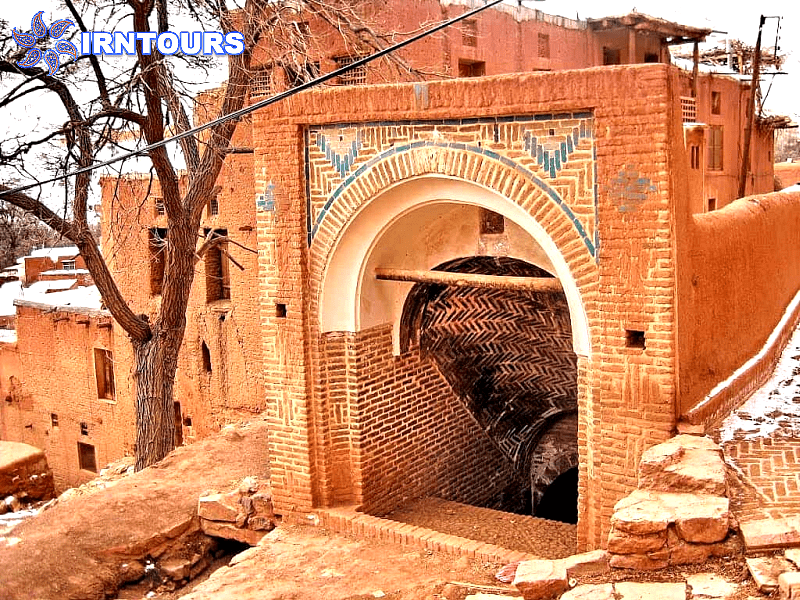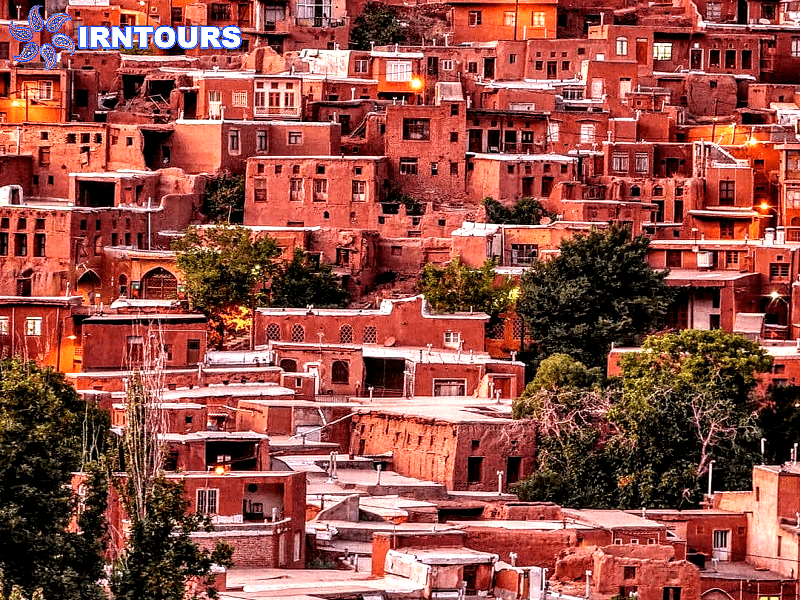Sultan Amir Ahmad bath
Amir Sultan Ahmad Kashan bath is one of the most beautiful baths in Iran and one of the best sightseeing places in Kashan, dating back to the Seljuk and Qajar eras. This bath, whose name can be seen in the list of national monuments of Iran, is a unique example of Iranian baths in terms of architecture and decorations, and is located in a historical neighborhood. For this reason, many attractions are located near it. Amir Sultan Ahmad bath is only one of the historical baths of Kashan city and other buildings such as Bagh Fin bath, Ghazno bath, Abdul Razzaq Khan bath, Mohtsham bath, etc. are also among the historical baths of this city.
The roof of Amir Sultan Ahmad bathhouse is one of the symbolic places of Kashan and the subject of many photographers. In addition, turquoise blue tiles and Zarfam, seven-layer stucco and architecture worthy of attention attract thousands of domestic and foreign tourists to this building every year. Visiting this building is recommended for people interested in history, tourism, architecture, restoration, history, photography, students and researchers. The spaces of the Sultan Amir Ahmed Kashan bathroom consist of a counter, vestibule, communication corridors, shower, cold room, hot room, king’s room, safe, cleaning room, toilets and two water wells. Stay with us to introduce you to Amir Sultan Ahmad Kashan bath, its history, architecture and different parts.
Introducing Sultan Amir Ahmad bath
Sultan Amir Ahmad Bath was registered in the list of national works of Iran on March 2, 1977 with registration number 1996. This building has been renovated several times since its construction, and the existence of 17 layers of restorations indicate its antiquity. Sultan Amir Ahmad Bath in 1996 with the help of the Board of Trustees for the Restoration and Reconstruction of Kashan Historical Buildings and Engineer Mahluji, the then Minister of Industries and Mines, the building was purchased by Kashan Municipality and its reconstruction and restoration project was under the supervision of Mr. Engineer Mehdi Houshmandinejad and with the cooperation of Master Seyed. Ali Akbar Hali and the late Dr. Afsari started so that this unique building would not be destroyed.
Sultan Amir Ahmed’s bathroom was changed to a traditional dining room and coffee house for a while; But today it is active as a museum under the welfare and recreation organization of Kashan municipality.
Where is Sultan Amir Ahmad bath ?
- Sultan Amir Ahmad bath is located in the historical context of Kashan city on Alavi street and Sultan Amir Ahmad mosque alley. This famous tourist attraction is located near many historical monuments, such as the house of the Boroujerdis, the house of the Abbasids, and the house of the Tabatabais, and for this reason, you can go to other places of interest in Kashan on foot after or before visiting it.
The distance between Sultan Amir Ahmad Bathhouse to Tehran is 250 km (two hours and 40 minutes) and to the center of Kashan, 4.6 km (eight minutes). This bath is about 200 km (two hours and 10 minutes) away from Isfahan. The distance between Sultan Amir Ahmad Bath and Fin Kashan Garden is 11 km (16 minutes). - There are two routes to reach Kashan from Tehran, both of which are shared from Qom onwards. In the first and faster route, you will go to Kashan via Tehran-Qom freeway. The second route, which is a little longer (270 km), will take you to Kashan through Tehran Varamin highway and Qom Garmsar highway. The route is about three hours and 20 minutes.
To access the Sultan Amir Ahmed Bath on Amir Kabir Highway (Qom Kashan), after passing the Kashan Qom tollbooth on the right side of the road, take the right exit and enter Imam Reza Blvd. Continue on this boulevard and go straight through the first two squares until you reach the third square (Imam Hassan square). Exit from the first exit of the square and enter Shahidan Sotoudeh Boulevard. Continue on this boulevard and go straight through the first two squares until you reach the third square (Gazi Asadullah Square). Turn the square to the left and enter Fazel Naraghi Street. Continue this street until you see Alavi alley on your right. Continue on this alley for about 400 meters (two minutes) until you reach Sultan Amir Ahmed alley on your right. The bathroom is located in this alley. - Address : Alavi Street, Sultan Amir Ahmad Alley, Kashan City
- Contact Number : +983155220038
History of Sultan Amir Ahmad bath
Sultan Amir Ahmad bath takes its name from the adjacent Imamzadeh, the grandson of Imam Javad (a.s.). The evidence and works obtained from this bath after the devastating earthquake of 1771 show that its history goes back to the Seljuk era; But Sarbineh Hamam belongs to the Qajar period. Of course, some believe that the bath we see today in Kashan was built on the ruins of the old bath during the Qajar era in 1875 and a small bath was added to its collection.
It is interesting to know that in the past, every city had five main elements, including a mosque, a market, a house, a bath, and a reservoir; For this reason, Sultan Amir Ahmad bath can be considered as one of the important elements of the city. According to the remaining documents from different historical periods, in all Islamic periods, there were many public baths in the cities; So that they were compared with mosques in terms of number and importance.
The historical baths of Kashan, in the Safavid era, were among the buildings that were praised by domestic and foreign tourists. Chardin, the famous French traveler, writes about these buildings as follows:
Kashan hot springs are excellent, good and clean.
Sultan Amir Ahmed bath architecture
The bathroom is considered one of the most complex buildings; Because the principles of its construction are very difficult. Traditional baths were built in the past to keep the internal heat below ground level and in the soil to save energy.
Sultan Amir Ahmad’s bath is in the form of a large octagonal hall with an octagonal basin in the middle. Its middle space is also surrounded by eight columns that separate the sitting spaces from the middle space. Sultan Amir Ahmed bath with 1,102 square meters of area, has very eye-catching decorations, and its limestone and plaster work dazzles the eyes of every viewer. Lime cutting refers to the art of carving relief patterns on a surface of lime; An art that is considered one of the beautiful decorations of Iranian buildings.
Turquoise blue and gold tiles, seven-layer plasters and special architecture have made Sultan Amir Ahmad bath one of the most prominent baths in Iran. The use of vaulted ceilings, eye-catching mosaics and wall paintings are other features of this bathroom that have given it a unique charm.
In the Sultan Amir Ahmed bath, two wells are used to supply water, and clay pipes or tubusheh are used to transfer water between different parts of the bath. Colored glass called Goljam in the hole in the ceiling or wall of the bathroom is another notable feature of this building’s architecture. Sultan Amir Ahmad bath does not have many stairs; But it is possible that the elderly and the disabled may have problems visiting this building.
Different parts of Sultan Amir Ahmad bath
In general, the Sultan Amir Ahmad bath generally includes two small and large baths, which were used by the people of Kashan in the past and on some days of the week. In the following, we will introduce you to the different parts of the bathroom.
Large bathroom :
- Entrance : In old bathrooms, you have to go through several spaces to enter the dressing room (the first large space in the bathrooms).
Jalokhan: an area of the entrance that is located before the entrance and in front of it.
Entrance gate : The gate is one of the important parts of the architecture of old Iran and characteristic of the building. The head of the Sultan Amir Ahmad bath is decorated with beautiful motifs, among which we can mention the motifs of flowers and pigeons, as well as statues and images of men and women, and images of hunting grounds around the city. Unfortunately, some of these motifs have been severely damaged. The main part is decorated with tiled backs, Yazdi arches and moqrans carved arches, and the stucco above the door and other parts of the main part show a special elegance and beauty to the viewer’s eyes.
Vestibule and communication corridor : This section is located at the entrance of the building and is located immediately after the entrance and door. The vestibule is a space for communication between outside and inside. This space is connected to the inside of the building using a corridor. A simple and well-proportioned formalization can be seen in the vestibule ceiling of the Sultan Amir Ahmad bath. Formalization is an evolved form of cornering where, using a single mould, arches are placed at intervals of the four main arches, thus turning the square into an octagon. After passing through the vestibule, you will encounter a winding hallway that leads to Serbineh. The reason for the existence of winding corridors between the vestibule and the headroom is that the sudden change in air temperature does not disturb the visitors and convection does not take place between the hot air of the bathroom and the cold air outside. - Serbina : Sarbineh or bineh is the first important space of bathrooms. Sarbineh is actually a kind of dressing room and a place to prepare for bathing or leaving the bathroom. This section is located between the entrance to the bathroom and the greenhouse. In the past, the air in Sarbineh was kept semi-warm so that customers would not face hot air all at once; In addition, when leaving the hot house, the cold air will not hit them and there will be no problems for people’s health.
The most decorated baths are seen in Sarbineh, and Sultan Amir Ahmad bath is no exception. There is precise and regular lighting in Serbineh; An indicator that doubles the effect of existing decorations and creates a stunning atmosphere. Sultan Amir Ahmad’s bathhouse is built in an octagonal shape, and its beautiful stucco and formalized ceiling are among its attractions. The stone shoe racks of this section are also really beautiful next to the columns and walls decorated with mosaic tiles. The floor of Sarbineh and the platforms around it are stone.
The plinth (a part of the wall of the room or porch that covers from the floor of the niche to the floor) is tiled in the bathhouse of Sultan Amir Ahmad, and in combination with the tiling of the middle dome of this section, it creates a beautiful atmosphere. The tiling of this section is of the bell type, where clay tiles are used; The tiles that have a glass glaze on them and are fired in the oven.
On the roof of Sarbineh, the phrase “La-e-el-e-Allah” is engraved in the direction of the Qibla, and on the opposite side, the date 1875 shows the restoration of the place after the devastating earthquake of the Zandiyeh period. It is said that this roof was destroyed in this earthquake and at the same time as the house of Borujerdi was built in its vicinity, the construction of brick roof and tiling was done. In the middle of the formalization of the roof and exactly above the pond, there is a large skylight with tile patterns on its edge.
One of the questions of the visitors about Sultan Amir Ahmad’s bathhouse is why this section is so large. The answer to this question lies in the use of the bathroom in the past. In the old days, the bathroom was not only a place for washing the body, but it was used as a place for gathering friends and solving life issues, spending leisure time, talking, relieving fatigue, and even worshiping; For this reason, the headspace is very large. - in between :After passing through Sarbineh, you will face a space called “Miyan Dar” which will take you to the greenhouse with two 90 degree turns. “Miyan door” has a meandering design to prevent the direct exchange of heat and humidity and prevent the air from outside the bathroom from being transferred to the greenhouse and the air from the greenhouse to the greenhouse and vice versa. The entrance to the greenhouse and its exit to the greenhouse are placed opposite each other to maintain the axis of the space. Other service spaces, including washrooms and cleaning spaces, were also located “between the doors”.
- warm house : The hot room is the second main space of the Sultan Amir Ahmad bath, which was used for washing and purifying the body in the past. The warm atmosphere of the house is simpler than Sarbineh and there are corners for sitting and washing.
The plinth and the warm wall of the house are decorated up to one meter with mosaic tiles, and from there to the ceiling, there is limestone with Saroj mortar. Saroj is a water-resistant mortar made from lime and ash, clay, etc. Four columns divide the warm space of the house into three middle parts (the road and getting to the treasury) and two smaller parts in the periphery (for sitting and bathing); Sections that each have a pond in the middle. - Treasury : Hot water tank, cold water pool and more private spaces for bathing are located next to the hot house. The door of the bathroom safe is installed right in the middle of the opposite side of the entrance.
The treasury is a small room for washing, which is located on the “Golkhan” and it is half filled with water. In the past, in full baths, there were three vaults, one for hot water, one for cold water, and in the middle of the two, a vault for lukewarm water. At the time, no one was allowed to step in both cold and hot water reservoirs.
Garam was a private house in two corners of the treasury for nobles and nobles. Instead of a treasury, these spaces had a small basin called a handstand, from which people took water and poured it on themselves. The arches and parts of the greenhouse were decorated with limestone; Decorations that have unfortunately suffered a lot of damage over time. Toize is a plaster part of the building on the ground, on which the arch is mounted, and it is the factor of transferring compressive loads to the side and bottom walls. - Tun or Gulkhan : Some of the bathroom spaces were built for support, among which we can mention the spaces for water and heat supply, such as tun and firewood storage. Tun, Gulkhan, Tun or Pathion refers to the set of corridors, chambers and copper dishes that are located on the floor and under the treasury.
A copper dish in the form of a small pit was placed in the bottom and center of the treasury. Under this container, there is a chamber that leads out of the bathroom through a corridor. At regular intervals, a person named “Toon Tab” lit firewood and other fuel in the ton to keep the water in the tank warm. The smoke from burning firewood in the oven did not go directly to the chimney; Rather, he first passed through the cat faces on the bathroom floor.
Catholes are ventilation holes under the floor of the hot house, which have different corridors and smoke and fire exited the bathroom through them and then through the chimney. The chimneys actually played the role of modern radiators in the bathroom, and passing the smoke through the chimneys warmed the bathroom floor. In Sarbineh, there are fewer of these cats so that the air is semi-warm. - Small bathroom : A small bathroom is a bathroom with a simple entrance that leads to the bathroom after passing through its corridor. The head space of the small bathroom has a base of eight and a half eight and platforms can be seen around it. The formal arch above the headboard and the ceiling and plinth decorations of this space are similar to the headboard of the large bathroom.
- bathroom roof : The roof of the Sultan Amir Ahmad bathhouse is the masterpiece of this building and one of the most beautiful dome-shaped roofs in Iran. So, when visiting this building, don’t forget to go to its roof and take souvenir photos. There are a number of domes on the roof of this bathroom, each of which has convex lens glasses. The reason for installing these lenses is to provide enough light to different parts of the bathroom and prevent the view inside. It is interesting to know that the ancients believed that the devil’s eye looks into the bathroom.The interior light of the bathroom spaces was provided by Jamkhaneh or Goljam and directly from the ceiling of the bathroom, and nowadays artificial lights also help to illuminate the space. These glass elements can be seen throughout the roof space and provide the bathroom with light all year round.
The number of glasses in the cups is based on the area of Sultan Amir Ahmed’s bath; In addition, the diameter of the cups and their number are determined depending on the heat and cold of the space below them. In some seasons of the year, the temperature and humidity of the air in Sarbineh was adjusted by removing the glajams of this skylight. In the past, the roof of the bathrooms was also a place to dry people’s clothes, lang and velor (a large towel for drying the upper half of the body); For this purpose, there was a staircase to access the roof.
Conditions for visiting Sultan Amir Ahmad bath
Sultan Amir Ahmad bath is open all year round except during mourning days from 9:00 to 18:30.
Staying near Sultan Amir Ahmad bath
To stay in Kashan, many tourists go to traditional ecotourism hotels in the historical context of the city to experience a pleasant stay and get to know the local culture of the region in addition to access to urban attractions. Mahinstan Rahab Hotel, Ariana Traditional Hotel, Atlasi Hotel, Morshedi Boutique Hotel, Surijan Boutique Hotel, Ameriha Hotel, Neh Cham Historical Hotel, and Doll and Toy Museum Eco-Residence are just some of the hotels in Kashan where you can stay.
The best time to visit Sultan Amir Ahmad bath
The best time to travel to Kashan and visit Sultan Amir Ahmed Bath is from early April to early June (with an average temperature of 22°C) and from early October to early November (with an average temperature of 20°C). Of course, if you plan to participate in one of the most important festivals of the country, the Kashan Rose Water Festival, travel to this city in April and June.
Some tourists also prefer the autumn season to travel to Kashan; The time when nature delights with yellow, orange and red colors and creates an unforgettable experience for you.
Kashan is a desert city and therefore has very hot summers and relatively cold winters. Early July to early August is the hottest time in Kashan, and the average temperature reaches 33 degrees Celsius at this time. The minimum and maximum temperatures at this time are 41.3 and 25 degrees Celsius. The coldest time in Kashan is from early January to early March, and the average temperature of the city reaches five degrees Celsius at this time. The minimum and maximum temperatures of this city are zero and 10 degrees Celsius respectively. Therefore, we advise you not to travel to Kashan in winter and summer so that the weather conditions do not bother you.
Sightseeing places around Sultan Amir Ahmed bath
- The historical house of the Tabatabais : The Tabatabai house complex is one of the nationally registered works and one of the historical houses of Kashan, which includes three internal and external parts and a special part for the crew. This house was built by a person named “Hajj Seyyed Jafar Tabatabai Natanzi”, a famous carpet merchant, and because of this, it became known as the house of the Tabatabais. The historical house complex of the Tabatabais has 4,700 square meters of area, has 40 rooms, four courtyards, four cellars (basements), three wind towers and two aqueducts. The central yard belonged to the outer part, two yards belonged to the inner part, and one yard belonged to the crew.
The architecture of Tabatabai’s house is symmetrical and introverted in the style of hijab-dar and garden-pit architecture, and it dates back to the Qajar period. The construction of this house lasted for 10 years, and its stucco motifs include Persian carpets, flowers, and slimy chickens. The exterior of the house includes a large royal hall, which is the most beautiful part of the building with skylights and colored mesh windows and double-glazed side windows that open and close vertically. This room is decorated with paintings, mirrors and stucco, including plaster lattice windows that look like fine lace fabric.
Distance from Sultan Amir Ahmed Bath by foot: 200 meters (two minutes)
Phone: +9831 55320032
Address: Alavi Street, Kashan
Hours of operation: every day from 8 to 18 - Residence and house of doll and toy museum : The house of Kashan doll and toy museum is an old house attributed to Jafar Allameh Faizi, a late Qajar poet and cleric, which dates back to more than 150 years ago. This building is registered under the name of Sohrabi House in the list of national monuments of Iran. The Kashan Doll and Toy Museum has collected examples of the oldest dolls, toys and marionettes from the Qajar period. Performance of traditional marquee, toy and doll making workshop, handmade toy and doll shop, cafe and pantry are other parts of this museum.
In the winter of 2016, after restoration operations, a residential section was added to the historical doll and toy museum, which today operates under the title of the doll and toy museum ecotourism residence. The residence of this complex also has seven rooms around a large yard. The geographical location of the Kashan Toy Doll Museum House on Fazel Naraghi St. provides easy access to many historical attractions of Kashan city, and for this reason, many tourists choose it to stay.
Distance from Sultan Amir Ahmad Bath by foot: 280 meters (four minutes)
Phone: +9831 55225134
Address: Alavi Street, Kashan - Taj historical house : The Taj House is one of the authentic garden pit buildings of Kashan dating back two centuries (Qajar era), which is known today as the Kashan Artists’ House and Museum of Anthropology and has a cultural use. This three-story historical building (ground floor, garden pit and lower cellar) has 700 square meters of area and 800 square meters of nobles. The Taj house has two exterior and interior courtyard doors and 13 five-door, three-door, and single-door rooms.
Among the important architectural spaces of the Taj house, we can mention four outer cellars, two inner cellars, a wind tower, Shahneshin, Mehtabi, entrance vestibule, Sharm (around the garden of the middle floor) and Spring of Dreams. This building was purchased, restored and renovated in 2013 by the architect of Kashan historical buildings, Seyyed Akbar Hali. The Taj House is registered in the list of national monuments of the country.
Distance from Sultan Amir Ahmad Bath by foot: 290 meters (four minutes)
Phone: +9831 55224868
Address: Alavi Street, Kashan
Hours of operation: every day from 8:00 to 18:00 - The historical house of Boroujerdis : The historical house of Boroujerdi is one of the most important historical monuments of Kashan city, it is located in Sultan Mirahmad neighborhood and it was built by Seyed Hasan Natanzi, a businessman. A person who at that time became known as Borujerdi because of his many trips to Borujerd. This building dates back to the Qajar period and the second half of the 13th century. The building is registered in the list of national monuments of the country. This house displays one of the most beautiful effects of Iranian architecture with its beautiful crescent-shaped windbreaks on the roof of the hall and the kerchief on it.
The area of Boroujerdi’s house is 1,700 square meters and its infrastructure is 1,000 square meters. This house includes two external and internal parts, two main and secondary entrances, vestibule, corridor, yard, summer house, winter house, kitchen, covered yards and large underground. The Boroujerdi house has two floors and a three-floor cellar in the southern part. The decorations of this building, including paintings and plasters, were done by Sani al-Molk, a great Iranian painter, and Kamal al-Molk. The architect of this building is Ali Maryam Kashani.
The story of building the Boroujerdi house is a romantic story. Seyed Hassan Natanzi, the builder and owner of this building, falls in love with the daughter of Seyed Jafar Tabatabai Natanzi, one of the biggest carpet merchants of that period. Tabatabai also sets a condition for marriage. He asks the suitor to build a house as beautiful as his own (the house of the Tabatabais). By accepting this condition, Seyyed Hassan finished the construction of the inner courtyard of the Boroujerdi house and settled in the house.Distance from Sultan Amir Ahmad Bath by foot: 300 meters (four minutes)
Phone: +983155223777
Address: Alavi Street, Kashan
Hours of operation: Saturday to Wednesday 8:00 a.m. to 3:00 p.m., Thursday and Friday 9:00 a.m. to 4:00 p.m
Tips for visiting Kashan market
- Muharram mourning is celebrated with special enthusiasm and splendor in Kashan market, and if you travel to this city during these days, do not miss it.
- The working hours of Kashan bazaar are from 9:30 in the morning to the call to prayer at noon (around 12:00) and in the evening from 17:00 to 21:00.
- Among the tourist attractions near Kashan market, we can mention Agha Bozor Mosque and Madrasa, Sultan Amir Ahmed Bath and Boroujerdi House, which are worth visiting.


